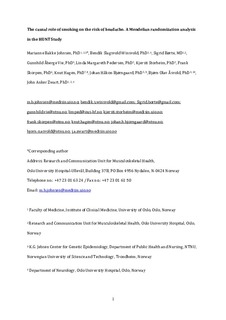| dc.contributor.author | Johnsen, Marianne Bakke | |
| dc.contributor.author | Winsvold, Bendik K S | |
| dc.contributor.author | Børte, Sigrid | |
| dc.contributor.author | Vie, Gunnhild Åberge | |
| dc.contributor.author | Pedersen, Linda Margareth | |
| dc.contributor.author | Storheim, Kjersti | |
| dc.contributor.author | Skorpen, Frank | |
| dc.contributor.author | Hagen, Knut | |
| dc.contributor.author | Bjørngaard, Johan Håkon | |
| dc.contributor.author | Åsvold, Bjørn Olav | |
| dc.contributor.author | Zwart, John-Anker | |
| dc.date.accessioned | 2018-12-18T13:05:09Z | |
| dc.date.available | 2018-12-18T13:05:09Z | |
| dc.date.created | 2018-05-14T08:44:33Z | |
| dc.date.issued | 2018 | |
| dc.identifier.citation | European Journal of Neurology. 2018, 25 (9), 1148-e102. | nb_NO |
| dc.identifier.issn | 1351-5101 | |
| dc.identifier.uri | http://hdl.handle.net/11250/2578104 | |
| dc.description.abstract | Background and purpose
Headache has been associated with various lifestyle and psychosocial factors, one of which is smoking. The aim of the present study was to investigate whether the association between smoking intensity and headache is likely to be causal.
Method
A total of 58 316 participants from the Nord‐Trøndelag Health (HUNT) study with information on headache status were genotyped for the rs1051730 C>T single‐nucleotide polymorphism (SNP). The SNP was used as an instrument for smoking intensity in a Mendelian randomization analysis. The association between rs1051730 T alleles and headache was estimated by odds ratios with 95% confidence intervals. Additionally, the association between the SNP and migraine or non‐migrainous headache versus no headache was investigated. All analyses were adjusted for age and sex.
Results
There was no strong evidence that the rs1051730 T allele was associated with headache in ever smokers (odds ratio 0.99, 95% confidence interval 0.95–1.02). Similarly, there was no association between the rs1051730 T allele and migraine or non‐migrainous headache versus no headache.
Conclusion
The findings from this study do not support that there is a strong causal relationship between smoking intensity and any type of headache. Larger Mendelian randomization studies are required to examine whether higher smoking quantity can lead to a moderate increase in the risk of headache subtypes. | nb_NO |
| dc.language.iso | eng | nb_NO |
| dc.publisher | Wiley | nb_NO |
| dc.title | The causal role of smoking on the risk of headache. A Mendelian randomization analysis in the HUNT Study | nb_NO |
| dc.type | Journal article | nb_NO |
| dc.type | Peer reviewed | nb_NO |
| dc.description.version | acceptedVersion | nb_NO |
| dc.source.pagenumber | 1148-e102 | nb_NO |
| dc.source.volume | 25 | nb_NO |
| dc.source.journal | European Journal of Neurology | nb_NO |
| dc.source.issue | 9 | nb_NO |
| dc.identifier.doi | 10.1111/ene.13675 | |
| dc.identifier.cristin | 1584758 | |
| dc.description.localcode | Locked until 10.5.2019 due to copyright restrictions. This is the peer reviewed version of an article, which has been published in final form at [https://doi.org/10.1111/ene.13675]. This article may be used for non-commercial purposes in accordance with Wiley Terms and Conditions for Self-Archiving. | nb_NO |
| cristin.unitcode | 194,65,20,0 | |
| cristin.unitcode | 194,65,15,0 | |
| cristin.unitcode | 194,65,30,0 | |
| cristin.unitcode | 194,65,20,15 | |
| cristin.unitname | Institutt for samfunnsmedisin og sykepleie | |
| cristin.unitname | Institutt for klinisk og molekylær medisin | |
| cristin.unitname | Institutt for nevromedisin og bevegelsesvitenskap | |
| cristin.unitname | Helseundersøkelsen i Nord-Trøndelag | |
| cristin.ispublished | true | |
| cristin.fulltext | postprint | |
| cristin.qualitycode | 2 | |
